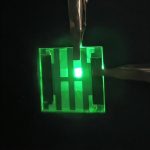Astronomers find water traces in an interstellar visitor
For millions of years, a tiny icy fragment wandered through space—like a sealed bottle drifting across a cosmic ocean.
This summer, that “message in a...
Scientists use light to create electron gas, opening door to ultra-fast electronics
Imagine future smartphones and computers that run on light instead of electricity—making them faster, more efficient, and cooler to the touch.
Scientists have now taken...
Study shows what’s really hiding in plastic bottled water
The beautiful beaches of Thailand’s Phi Phi Islands may seem like an odd place to begin a PhD journey, but for Sarah Sajedi, a...
Scientists create sustainable plastic from the carbon dioxide in the ocean
The ocean absorbs about a quarter of all carbon dioxide (CO₂) released by human activity, helping to slow climate change—but at a cost.
This constant...
Paper-thin LED shines like the sun and could transform future screens
Imagine wallpaper that glows like natural sunlight or a phone screen that’s easy on your eyes even at night.
Scientists have now developed a paper-thin...
Scientists turn used water bottles into powerful, recyclable energy devices
Every year, more than 500 billion plastic water bottles are produced worldwide, most of them used only once before being thrown away.
Now, scientists have...
Scientists use microwaves to make chemical reactions more energy efficient
Heating is one of the most energy-hungry steps in industrial chemistry, but scientists from the University of Tokyo have found a clever way to...
Scientists achieve record efficiency in inorganic perovskite solar cells
Solar energy is one of the fastest-growing renewable technologies, but scientists are constantly searching for ways to make solar panels more efficient, affordable, and...
Solar energy becomes the world’s cheapest energy source, study finds
Solar energy has officially become the cheapest way to produce electricity, beating coal, gas, and even wind power, according to new research from the...
Stretchable waveguides could turn clothes into smart health monitors
Imagine clothing that not only feels comfortable but can also track your health, help you communicate, and connect seamlessly with technology around you.
Scientists are...










